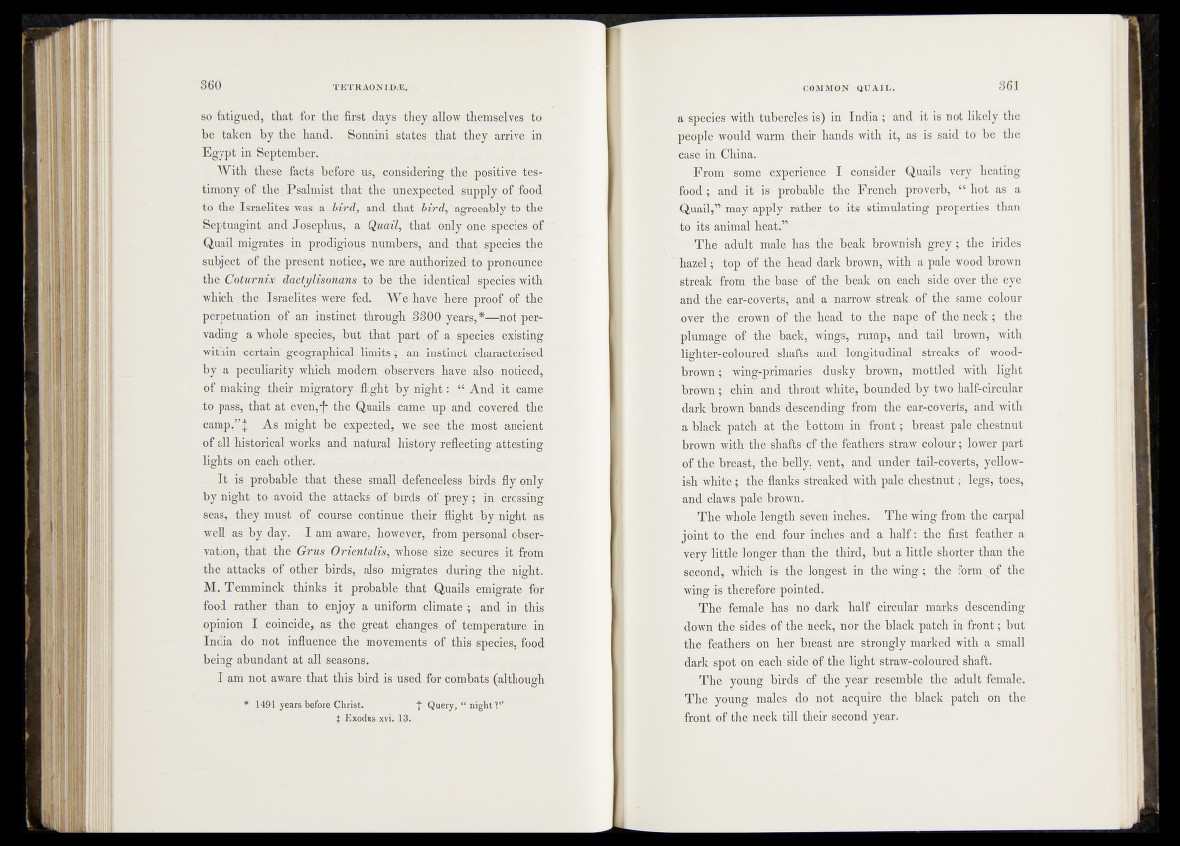
so fatigued, that fox the first . da^&ithey^ll^îthejnsd.Yes to
be taken by .the. hand. ^Sonnini .states that.'they arrive in
Egypt in September.
‘ With these facts hefdreuMS,- considering;, the. .pbsitMg^Çes-
timony of the „Psalmist that- t^^Tme^peçtëà’^ p p Iÿ of‘ food
to the Israelites vj[as .a .bird, and -that bird, agreeably, to the
Septuagint and Josephus-, 'a Q w a ^ th a t only ojfe-spqçies. o f
Quail migrates-in prodigious-numbers, ..and jthat, .specicg^fe
subject of the',present notice, we,;areauthorizednto pr^mmaicp
the Coturnix daetylisonans to bejthq, .identical species "with
which'-the Israelites were „fed. We have "here-propf of-the
perpetuation of an ihstmct through jï3,®Q;,ÿéafs,*—n o t^ r ?
vading a whole... specie^but fhat parWp&a, apedej^ existing
within certain geographical .lim its^ an, instinct- characterised
by a.'peculiarity which modern..observers „have ^sq^ |K)|fcedf
of making their migratory flight benight- *Jl And it came
-to pass, that at ^ven,j* the Quails came> up and cp^éiffi^lè'
camp.” j As might be expected, we .seethe rU^osfc: ancient-
of all historical Works and natural hi&tory reflecting attesting
lights, on. eachmtherl
I t is.: probable that these small defenceless .birds jly only
by night to -avoid.the"attacks of birds -of ‘prey ; in crossing
seas, they must tof ..course continue their flight.-h«ffikigh^ as
well-as by day. I am' aware, howeyet, - from personaTohsep:
vation, that the Grus.Orientalù,,whose-.size secures it from
the.attacks of other birds,-also migrates during the” night.
M. Temminck thinks it probable that Quails emigrate for
food rather than to enjpy a uniform climate ; and in this
Opinion I coincide, as the great changes of temperature in
India do not influence the movements of this species, food
being abundant at all seasons,
I am not. aware that this bird is used for combats (although
* 1491 years before Christ. ' f Query, “ night '
I Exodus xvi. 13.
a species with tubercle^is) in India ; and it is not likely the
peopl^wbuld warm theif' hands with it, as is said to be the
^ase in China,
Prom some ^xperi^feb" I consider Quails very heating
food; and ?ivis- probable/'t» French proverb, “ hot as a
Quail,” may apply --latKlfe tb its ^stimulating properties than
f©1 its animal heat:”'
The adult male- has t l ‘e Beak brownish grey; the irides
TtazCl|s^^|-6f tlie'lle?ic^dMk‘brown, with a pale wood brown
streak from tn ^P ^K c ^ lK e beak* on each side over the eye
and the ear-c<5^lpv,and a harrow streak of the same colour
over w e ’crown of the head to the4' nape of the neck; the
plumage ojKthe back, wings, ruthp, and tail brown, with
l-ghterfcMbtir'e^ shafts ^and'-' longitudinal streaks of wood-
brown wing-primaries1- dusky. '-brown, ‘mottled with light
chin1 and throat'white, bounded by two half-circular
darker own Ban JsffMsbending from |fee bar-coverts, and with
R-blaclhpatch at the bottom.in front; breast pale chestnut
brown with^^^ahufts1’o fih e feathers -straw colour ;:ldwer part
oiffhe breast, the belly, vent,' and under tail-coverts, yellow-
, isl\ r f l p ^ e flanks streaked with pale chestnut; legs, toes,
and cla^§i|pale brown'.
The whole 1 engtFs&yhhririches. The wing from the carpal
/ joint"fo- the’ end four inchesjand a half: the first feather a
- very little longer than the third, but a little shorter than the
second, which i’s: tlM longest in the wing ; the form^of the
wing is therefore pointed.
'-.’The- felnale has no dark half circular marks descending
down the sides of the neck, nor the- black patch in front; but
the feathers on her breast are strongly marked with a small
dark spot on each side of the light straw-coloured shaft.
The young birds of the year resemble the adult female.
The young males do not acquire the black patch on the
front of the neck till their second year.